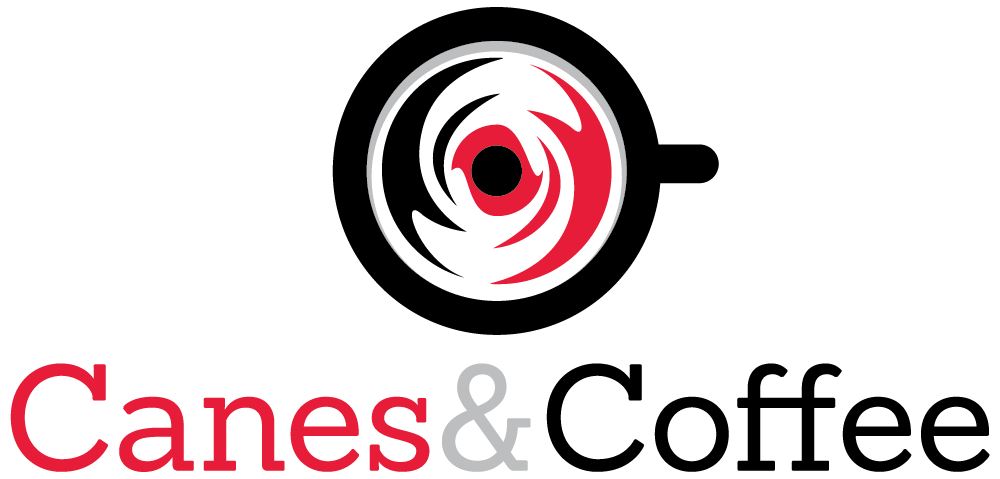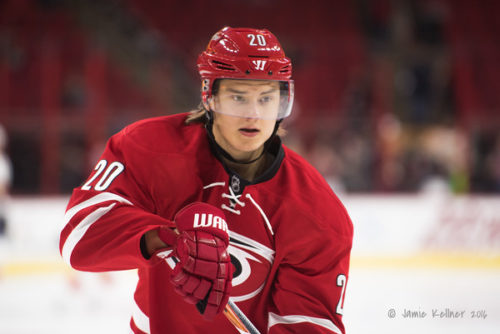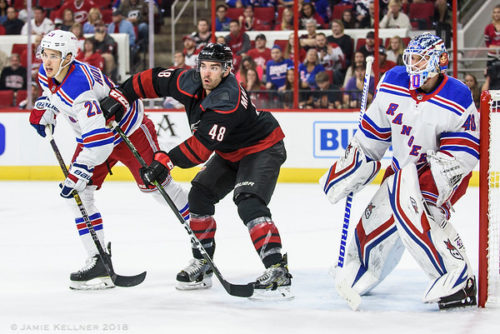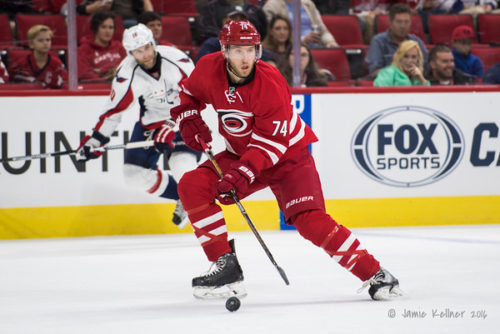After Saturday’s home loss to the Philadelphia Flyers that marked the second straight debilitating home loss, the Carolina Hurricanes still have 11 games remaining in the 2017-18 season. Right now, that feels like about 10 too many, but with no possibility of just waving a white flag at the remainder of the season the team and the part of the fan base that has not yet been able to detach must trudge through 11 more games.
It starts with a match up against the New York Islanders in Brooklyn on Sunday night. With both teams sputtering right now, the game shapes up as a battle for last place in the Metropolitan Division and also for draft lottery positioning.
Bigger picture, the game represents another try for the Hurricanes to try to take a step in the direction of righting a ship that has been taking on water of late.
‘What I’m watching’ for the Carolina Hurricanes versus the New York Islanders
1) Determination not tentativeness
After couple horrible third periods at home this week, some amount of self doubt seems inevitable heading into Sunday’s game. Ideally, the Hurricanes will use frustration from two tough losses to fuel determination and help the team find a higher gear. But with the potential to just become tentative, this is something I will be watching from the outset on Sunday night against the Islanders.
2) A continuation of the blue line offense
One positive from Saturday’s loss was a decent game offensively for the blue line. Noah Hanifin stepped up into the play and had a good scoring chance early in the first period and then two even better chances on a close range shot and a rebound later in the first period. Jaccob Slavin was similarly involved offensively and also rewarded on the score sheet with a goal and an assist. Slavin collected the assist on Jordan Staal’s goal when he got a shot through to the front of the net for Staal’s deflection goal. Then Slavin collected his own goal late. One of the things that continues to be missing from the Hurricanes young blue line is the ability to generate offense. Hanifin took strides in this regard early in the 2017-18 season but has slowed a bit of late. Slavin surged offensively late in the 2016-17 season and has been decent in terms of offensive production in 2017-18 when considering his lack of power play ice time but ideally has another gear in that regard. On Sunday, I will be watching if the Canes blue line can build on Saturday’s game offensively.
3) Signs of life in the face of adversity
More than anything, I will be watching for signs of life and a response in the face of adversity. As noted at the beginning of this preview, the rest of the schedule cannot just be canceled. As such, 11 games seems like a bunch right now. Can the team pull it together and rebound?
The puck drops at 5pm on Fox Sports Carolinas with John, Tripp and Mike.
Go Canes!




“The part of the fan base that has not yet been able to detach must trudge through 11 more games” that “feels like about 10 too many” and “with no possibility of just waving a white flag at the remainder of the season.”
That about sums it up for me. Probably for the players, too.
The canes have an opportunity to improve their draft position tonight.
Yesterday Peters indicated they have a 7-game plan which they “liked”. Those games include PHI (last night), NYI, EDM, ARI, OTT (2x), and NJD. Effectively these are all teams we should either beat or be competitive with. Then there is a 3-day break before the final 5 games. My expectation is that the team is going to look at making final rush – the white flag won’t be raised organizationally until after the NJD game. Personnel changed deferred until then? What bothered last night was Peters’ remark that there are players not fully vested but that those questions/issues won’t be addressed until the end of the season.
Matt, You are correct and I was wrong about Scott Walker. He did not play for us until the year after we won the Cup.
I did say that Tim Gleason came to us via trade from LA in late 2006. Both men were tough guys not known for their scoring skills. As a matter of fact, Gleason came to us because Jimmy Rutherford was impatient. In the 2005 draft he had selected Jack Johnson at number 2 overall. But Johnson refused to leave school to come to the Canes. So Rutherford traded him for Gleason. Jimmy knew we needed more grit. Jack Johnson went on to a great career as a big, tough, non-scoring defenseman for LA and Columbus. I guess that contradicts your contention that the Canes from 2005 on had gotten rid of all our big tough guys in favor of smaller skilled scorers.
Furthermore, you stated that in 2005 the NHL wanted to make the enforcer types obsolete by chastening their refs to enforce the rules against holding, hooking, interference, and obstruction more strictly.
Actually, that wasn’t so. A few years prior to the 2004-05 locked out non-season, the N.J. Devils began to employ a clutch and grab system for all of their players in order to control the neutral zone. It was very effective. Other teams adopted the same system. They found it to be very effective as well.
As a consequence,in the 2003-04 season, NHL games were averaging just 5.14 goals per game.
During the 2004-05 locked out non-season, the NHL, concerned about declining TV revenues from bored fans switching off the low scoring games, implemented several moves to increase scoring.
1) The NFL removed the red line to allow for more breakaways.
2) They created the trapezoid to prevent goalkeepers like Marty Brodeur from slowing the game down by handling the puck.
3) Reduced the size of goalkeeper equipment.
4) They moved the blue line back.
5) The NFL mandated it’s refs to employ zero-tolerance for hooking, holding, tripping, slashing, cross checking, and interference fouls.
The next season (2005-06), the NHL average goals per game increased to 6.16.
I agree with you that the Canes benefited from the zero-tolerance perhaps more than most other teams in our quest for the Cup that year. And I agree that our speed was a key. But the fact is that we never did completely away with our tough guys until recently.
By the way, referees have short memories. They didn’t make it all the way through the 2005-06 season before they went back to their old ways.
The next season (2006-07), the NHL scoring average dropped to 5.89 goals per game. It has been dropping ever since.
In the 2005-06 season, NHL teams logged 39,439 penalty minutes. That number has been decreasing steadily since then.
Either the team’s have cleaned up their play steadily over the years, or the refs have stopped enforcing the rules.
I think it’s the latter.
Sorry. My phone loves to correct me. I typed in NHL and my phone corrects to NFL.
The NHL is like a home owners association, rules are easy to create yet rarely enforced.